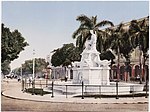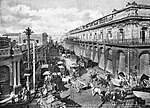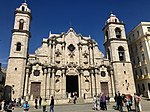Parque de la Fraternidad

The Parque de la Fraternidad (formerly the Campo de Marte) is a park in Havana, Cuba. It was built in the 1790s as a military practice range by the Spanish government; it was expanded in 1793 by Belgian engineer Agustin Cramer, and later the Bishop Espada improved the lighting of the Campo. It was Captain General Don Miguel Tacón who included it within the scope of his embellishment program. The area was then fenced and four majestic gates, crowned with coats of arms, each representing an important personality: the north gate, Hernán Cortés; the south one, Francisco Pizarro; and the east and west gates, Captain General (Spanish: Capitanía General de Cuba) Miguel Tacón y Rosique (1834-1838), and Christopher Columbus respectively. In 1928 it became the Parque de la Fraternidad.
Excerpt from the Wikipedia article Parque de la Fraternidad (License: CC BY-SA 3.0, Authors, Images).Parque de la Fraternidad
Avenida Simón Bolívar (Reina), Havana
Geographical coordinates (GPS) Address Nearby Places Show on map
Geographical coordinates (GPS)
| Latitude | Longitude |
|---|---|
| N 23.1331829 ° | E -82.3593186 ° |
Address
Árbol de la Fraternidad Americana
Avenida Simón Bolívar (Reina)
10000 Havana (Prado)
Havana, Cuba
Open on Google Maps










